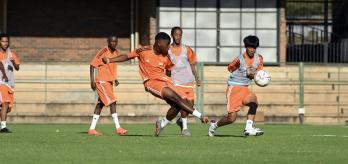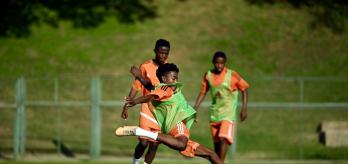Methodology
The intention: What is practised?
The objective of the exercise is to enhance a team’s ability to create and finish within a narrow focus. The drill works on team actions such as recognising the right moment to switch play and create an overload as a collective. The team are asked to use their awareness and read the game to recognise when one side of the exercise area is congested, and the opposition are unbalanced on the other side. The team must provide both depth and width and shift across into the spaces on the opposite channel in readiness for the switch pass. To take advantage of their numerical superiority, team members are encouraged to drive with the ball towards fixed, vulnerable opponents and make underlaps or overlaps to enhance their chances of creating goalscoring opportunities. Both attacking and defensive transitions are crucial aspects of this exercise, and both teams must be switched on to react quickly, especially when a new ball is introduced into the exercise area.
For whom is this relevant?
This 7v7 small-sided game revolves around the unit scale, with a particular emphasis on creating attacking overloads when the opposition are unbalanced. The exercise is relevant to all players involved in an attack that seeks to penetrate the opposition’s defensive structure, particularly wingers, full-backs and midfielders, whilst centre-backs can operate in a supporting role. When play is switched, wingers or wing-backs are encouraged to provide width on the opposite flank, while centre-backs or midfielders drop and provide depth for a support pass. The midfielders must try to identify the right moment to play a switch pass before quickly sprinting into the opposite channel. Full-backs can make underlaps or overlaps to support wingers once play has been switched. None of the players operate in the number 9 role. Whilst the drill is non-position-specific, players are asked to perform the role that they find themselves in, e.g. players in a wide area should act as wingers.
How is the practice designed?
The exercise involves an opposed, 8v6 small-sided game featuring variable repetition that provides ample opportunities for a team to practise switching play, attacking in wide areas, offering width and depth, and creating overloads. The reduced size of the exercise area and the number of players involved ensure that the wide channels become congested, which forces the in-possession team to shift the ball, and themselves, to the opposite channel. The set-up includes two mini-goals that give direction to the switches of play, with the in-possession team tasked with recognising when they are able to attack one of the mini-goals. Transitions into defensive or attacking structures are a key feature of the exercise, with teams able to take one of the balls on the outside of the exercise area after a goal has been scored or the ball goes out of play. The transitions serve as triggers for the in-possession team to react quickly to take advantage of imbalance in the opposition’s defensive structure to score and for the out-of-possession team to prevent a quick counter-attack.
Session plan
Organisation
-
Mark out a 35x35m exercise area.
-
At each end of the exercise area, position 2 mini-goals approximately 15m apart.
-
Place a number of balls along the sides of the exercise area.
-
Split the group into 2 teams of 8 and 6.
Explanation
-
The exercise begins with the second coach passing a ball to one of the teams from their position between 1 of the 2 sets of mini-goals.
-
The in-possession team must attack towards either of the mini-goals at the opposite end of the exercise area.
-
The out-of-possession team must try to win the ball back. If they manage to do so, they become the in-possession team and attack the opposition’s goal.
-
If the in-possession team put the ball out of play or score a goal, the other team can quickly restart play with any of the balls on the outside of the exercise area.
Key coaching points
Roles of coaches
-
First coach: leads the session and only intervenes when players are not performing the right actions to achieve the objective of the exercise.
-
Second coach: begins the exercise by passing the ball into one of the teams before offering support and encouragement from their position on one side of the exercise area.
- Third coach: offers support and encouragement from their position on the opposite side of the exercise area to the second coach.





















































